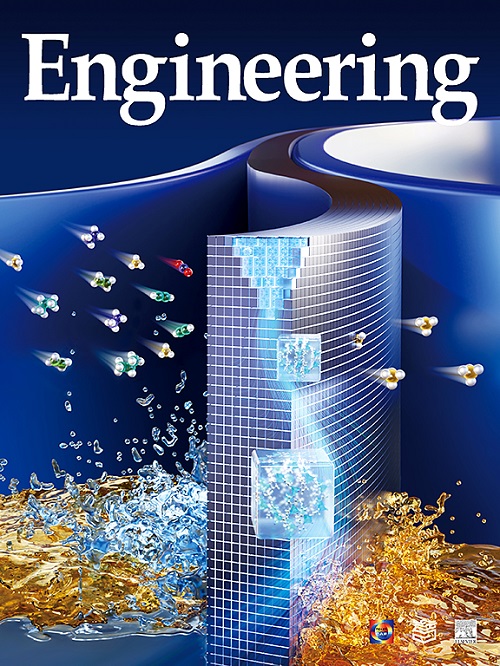Microbial-Enhanced Steel Slag Fixation of CO2 from Cement Kiln Flue Gas for the Production of Supplementary Cementitious Material
IF 11.6
1区 工程技术
Q1 ENGINEERING, MULTIDISCIPLINARY
引用次数: 0
Abstract
The production of cement and concrete using carbonated steel slag as a supplementary cementitious material achieves the dual benefits of efficient steel slag utilization and CO2 fixation. In this study, a combination of microbial technology and a rotary kiln process was employed to expedite the carbonation of steel slag for CO2 fixation from cement kiln flue gas. This approach resulted in a significant increase in the CO2-fixation rate, with a CO2-fixation ratio of approximately 10% achieved within 1 h and consistent performance across different seasons throughout the year. Investigation revealed that both the CO2-fixation ratio and the particle fineness are pivotal for increasing the soundness and reactivity of steel slag. When the CO2-fixation ratio exceeds 8% and the specific surface area is at least 300 m2∙kg−1, the soundness issue of steel slag can be effectively addressed, facilitating the safe utilization of steel slag. Residual microbes present in the carbonated steel slag powder act as nucleating sites, increasing the hydration rate of the silicate phases in Portland cement to form more hydration products. Microbial regulation results in the biogenic calcium carbonate having smaller crystal sizes, which facilitates the formation of monocarboaluminate to increase the strength of hardened cement paste. At the same CO2-fixation ratio, microbial mineralized steel slag powder exhibits greater hydration activity than carbonated steel slag powder. With a CO2-fixation ratio of 10% and a specific surface area of 600 m2∙kg−1, replacing 30% of cement clinker with microbial mineralized steel slag powder yields an activity index of 87.7%. This study provides a sustainable solution for reducing carbon emissions and safely and efficiently utilizing steel slag in the construction materials sector, while expanding the application scope of microbial technology.
微生物强化钢渣固化水泥窑烟气CO2生产补充胶凝材料的研究
碳化钢渣作为补充胶凝材料生产水泥和混凝土,实现了钢渣高效利用和CO2固定的双重效益。本研究采用微生物技术与回转窑工艺相结合的方法,加快了水泥窑烟气中钢渣碳化固CO2的速度。这种方法显著提高了co2固定率,在1小时内实现了约10%的co2固定率,并且在全年不同季节的表现一致。研究表明,固碳率和颗粒细度是提高钢渣稳定性和反应性的关键。当固co2比大于8%,且比表面积≥300 m2∙kg−1时,可有效解决钢渣的稳健性问题,有利于钢渣的安全利用。碳化钢渣粉中的残留微生物作为成核位点,提高硅酸盐水泥中硅酸盐相的水化速率,形成更多的水化产物。微生物调控导致生物源碳酸钙晶体尺寸变小,有利于单碳铝酸盐的形成,提高硬化水泥浆体的强度。在相同co2固定比下,微生物矿化钢渣粉的水化活性高于碳化钢渣粉。当固co2比为10%,比表面积为600 m2∙kg−1时,用微生物矿化钢渣粉替代30%的水泥熟料,活性指数为87.7%。本研究为建材行业减少碳排放、安全高效利用钢渣提供了可持续的解决方案,同时也拓展了微生物技术的应用范围。
本文章由计算机程序翻译,如有差异,请以英文原文为准。
求助全文
约1分钟内获得全文
求助全文
来源期刊

Engineering
Environmental Science-Environmental Engineering
自引率
1.60%
发文量
335
审稿时长
35 days
期刊介绍:
Engineering, an international open-access journal initiated by the Chinese Academy of Engineering (CAE) in 2015, serves as a distinguished platform for disseminating cutting-edge advancements in engineering R&D, sharing major research outputs, and highlighting key achievements worldwide. The journal's objectives encompass reporting progress in engineering science, fostering discussions on hot topics, addressing areas of interest, challenges, and prospects in engineering development, while considering human and environmental well-being and ethics in engineering. It aims to inspire breakthroughs and innovations with profound economic and social significance, propelling them to advanced international standards and transforming them into a new productive force. Ultimately, this endeavor seeks to bring about positive changes globally, benefit humanity, and shape a new future.
 求助内容:
求助内容: 应助结果提醒方式:
应助结果提醒方式:


